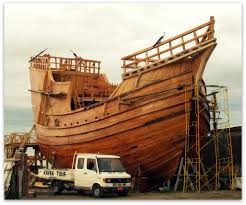As with mill construction shipbuilding requires generations of traditional knowledge. Wooden ships are stunning pearls of craftsmanship. And there were built for centuries entire fleets. An attempt to collect and preserve all this knowledge would be to expanded to include here.
 Especially oak was used for ships. An oak tree needs to grown 100 years at least. For a little liner 2,000 oaks were felled. (But only about half of the wood was used.) So there arose deforestation and shortages, even wars over forests.
Especially oak was used for ships. An oak tree needs to grown 100 years at least. For a little liner 2,000 oaks were felled. (But only about half of the wood was used.) So there arose deforestation and shortages, even wars over forests.
To make optimal use of wood, trees were allowed to grow into desired and useful shapes. So they got less waste, and stronger structures. Crookers were hard to find and expensive. All this just needed a tradition of several generations. Thus produced one in shape grown, ”grawn wood’ as a wrung piece knee to the main deck, mast jaw, straight, key piece, deck knee for verdeck (main deck), bolder, extension, knee forecastle deck, wryly, connector. Every yard of significance had his a specialist for this: the knee approver.
To protect the precious wood and ship against attack of rot, worms, various means were used. In galleys of the Roman Emperor Caligula (AD 12 -. 41 AD.) that were salvaged from the Lake Nemi, the skin is covered with wool fabric dipped in tar. On that lead plates were nailed. At the Portuguese the underwater part of the ship was roasted or grilled, so that a thick charred crust covered the skin. In the 17th century ships to the tropics were carried up to above the waterline with a double pine wall. Before this, the underlying hull was first roasted, dried, and tarred.
What would you take to a desert island? A boat. (Yvan Audouard)
